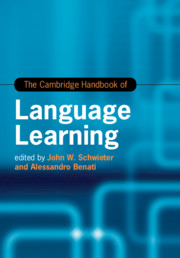Book contents
- The Cambridge Handbook of Language Learning
- Cambridge Handbooks in Language and Linguistics
- The Cambridge Handbook of Language Learning
- Copyright page
- Contents
- Figures
- Tables
- Contributors
- Acknowledgements
- Introduction
- Part I Theories
- Part II Methods
- Part III Skill Development
- 10 Interaction in L2 Learning
- 11 Speaking
- 12 Second Language Listening: Current Ideas, Current Issues
- 13 Contemporary Perspectives on L2 Upper-Register Text Processing
- 14 Language Learning Through Writing: Theoretical Perspectives and Empirical Evidence
- Part IV Individual Differences
- Part V Pedagogical Interventions and Approaches
- Part VI Context and Environment
- Part VII Moving Forward
- Index
- References
13 - Contemporary Perspectives on L2 Upper-Register Text Processing
from Part III - Skill Development
Published online by Cambridge University Press: 25 June 2019
- The Cambridge Handbook of Language Learning
- Cambridge Handbooks in Language and Linguistics
- The Cambridge Handbook of Language Learning
- Copyright page
- Contents
- Figures
- Tables
- Contributors
- Acknowledgements
- Introduction
- Part I Theories
- Part II Methods
- Part III Skill Development
- 10 Interaction in L2 Learning
- 11 Speaking
- 12 Second Language Listening: Current Ideas, Current Issues
- 13 Contemporary Perspectives on L2 Upper-Register Text Processing
- 14 Language Learning Through Writing: Theoretical Perspectives and Empirical Evidence
- Part IV Individual Differences
- Part V Pedagogical Interventions and Approaches
- Part VI Context and Environment
- Part VII Moving Forward
- Index
- References
Summary
Second-language (L2) reading research is replete with intellectual tensions: reading is the second-language skill with the greatest durability and usability and yet it is the most under-researched of the second language areas. While rooms could be filled with volumes and articles on how oral language develops and how that knowledge can be brought into instruction, on input and output hypotheses about the active use of the oral portion of second-language acquisition, or on the importance of pragmatic functions of language and how learners acquire them, the same cannot be said of knowledge about how learners interact with written text. A further paradoxical element is introduced by the notion of linguistic environment. While the environment of oral language appears to be most salient, the environment of written language is both more substantial and more linguistically complex. Oral language forms are much more simple than written forms, and they are far more lexically constrained than written language. An additional tension is introduced by the actual function of written material in the modern world. Adults use literacy in the workplace, be it a classroom, laboratory, or retail store. Reading complicated written material, seeking, as Guthrie and Greaney (1991) note, “knowledge gain … personal empowerment … participation in society … or occupational effectiveness” (pp. 73–75) is of paramount importance to functioning in the modern world, whether from a piece of paper or from a screen.
- Type
- Chapter
- Information
- The Cambridge Handbook of Language Learning , pp. 320 - 340Publisher: Cambridge University PressPrint publication year: 2019



